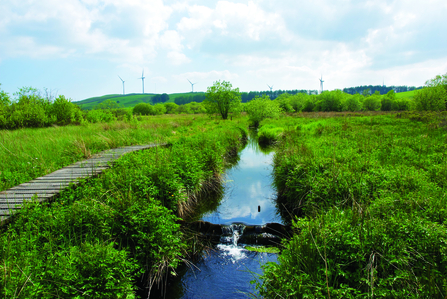
We have received funding to restore damaged areas of peatland at Burns Beck Moss Nature Reserve © John Morrison

We have received funding to restore damaged areas of peatland at Burns Beck Moss Nature Reserve © John Morrison
Restoring wild places like these is now incredibly urgent as we begin to see the changes that the climate crisis is having on the natural world.David HarpleyDirector of Nature Recovery, Cumbria Wildlife Trust
We have received funding from National Highways to repair 15 hectares of damaged peatlands at Burns Beck Moss Nature Reserve near Sedbergh. The funds, which are part of the Network for Nature programme, will be used to restore this wild site off the M6 near Killington to a functioning bog, which can efficiently lock away carbon.
As part of the restoration, work will start on re-naturalising or re-meandering a beck on the nature reserve, which had been straightened artificially in the past before we acquired the site. Restoration will enable water from the beck to spill out once more across sections of its floodplain, helping to rewet the landscape.
David Harpley, Director of Nature Recovery at Cumbria Wildlife Trust explained: “We’re delighted to receive this funding from National Highways, to help us restore damaged peat bogs at Burns Beck Moss. The site was damaged historically through peat cutting and attempts to drain the site, by straightening and deepening the beck and later digging a network of drains. This was done to prepare for tree planting, which was never carried out.
“We need to repair the damaged areas of this site by restoring the river course, raising the water levels and removing scrub which is damaging the bog. If we don’t restore the site, the bog will leak the carbon that it had locked away back into our atmosphere.”
We plan to restore Burns Beck Moss Nature Reserve to a healthy functioning bog, teeming with wildlife, making it a wonderful place for people to visit and experience. It will be protected from trampling underfoot by a newly upgraded boardwalk and information panels will tell visitors about this special site and the rich wildlife to be found there.
David Harpley explained why healthy peatlands are so important: “Healthy peatlands are vital for humans. 70% of our drinking water comes from upland areas dominated by peatlands. They help slow the flow of rainfall in storm events, reducing the risk of flooding and are wonderful places for wildlife, from roe deer, hare, heron and snipe to tawny owl and reed bunting. Importantly, healthy peatlands are able to store CO2 and stop carbon being released into the atmosphere. Restoring wild places like these is now incredibly urgent as we begin to see the changes that the climate crisis is having on the natural world. We're working with nature to lessen the effects of climate breakdown and to help wildlife – and society - adapt to the changes and challenges that lie ahead. The cool wet climate of northern Britain makes Cumbria a key stronghold for these vital peatland habitats and we are on the frontline of efforts to restore and protect them.”
Susan Stanley, Head of Designated Funds at National Highways said: “We’re committed to significantly improving biodiversity near our road network, and the partnership with The Wildlife Trusts will be a vital step in delivering a more sustainable road network that protects and enhances the environment.
“At National Highways, our work goes beyond operating, maintaining and improving roads; we’re investing in the environment and communities surrounding our network, helping to unlock the creation and enhancement of habitats, and this is an example of the difference we can make with designated funding.”
Burns Beck Moss is a wetland nature reserve of raised and valley mires, and is home to many animal and plant species. Raised and valley mires rarely occur together on the same site, and only a small number of Cumbrian sites, near Torver and Winster, are similar. Whilst raised mires are totally dependent on rainfall for moisture, valley mires receive ground water containing dissolved minerals and nutrients.
Although the nutrient levels vary between the mires, both sustain a variety of plants, including 16 species of Sphagnum moss, bog rosemary, cranberry, bog asphodel, round-leaved sundew and marsh cinquefoil.
Wildlife highlights to look out for at Burns Beck Moss include migrant and breeding birds, such as curlew, sedge warbler, willow warbler, grasshopper warbler, meadow pipit and whinchat in spring and summer.
National Highways is the company responsible for England’s motorways and major A-roads. Currently in its third year, National Highways’ Designated Funds programme is divided into four funding streams: environment and wellbeing, users and communities, safety and congestion and innovation and modernisation.
Network for Nature is an £8million programme managed by the Royal Society for Wildlife Trusts and funded through National Highways’ Environment and Wellbeing Designated Funds programme.
Over the next four years, 20 Wildlife Trusts in England are working on a huge range of projects from chalk downlands to boost rare butterflies, to creating and restoring wetlands, and conserving rare chalk streams for endangered water voles. Some Trusts are using natural solutions, like reedbeds and ponds to help filter polluted road run-off and stop it going into rivers or nature reserves. Overall, 39 biodiversity projects will enhance, restore and create more than 2,957 acres (1,197 hectares) of woodlands, grasslands, peatlands and wetlands across every region of England.